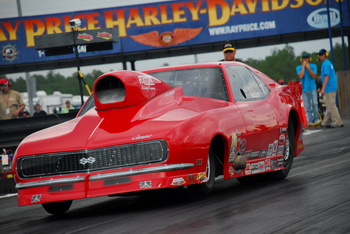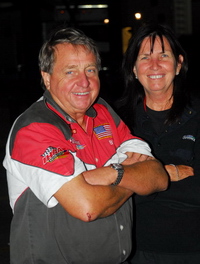WHERE HAVE THE NITROUS CARS GONE?
Many of today’s leading nitrous racers have proclaimed that for years and while many dismissed those claims as lobbying for a rule change, it has become clearly evident the disadvantage has been enough to keep them away in droves.
Many nitrous racers allege the IHRA has turned a deaf ear to their pleas and because of that they refuse to participate in what they clearly define as an un-level playing field. Others decline to even comment on the NHRA AMS situation.
During the 2007 season, the IHRA has rarely attracted over five nitrous entries per event. That’s a dramatic turnaround considering that in the first Pro Modified national event back in 1990, fifteen nitrous cars qualified.
The nitrous cars are still in existence, but many are flocking to the American Drag Racing League because of their willingness to split the Pro Modified class into two entities – nitrous and supercharged.
That’s the predominant question floating around the Pro Modified community

Pro Modified has made a transformation of monstrous proportions since 1990s inaugural season. A class built on the competitive mix of two diametrically opposite combinations and bearing the moniker of “run whatcha brung and hope you brung enough,” today’s Pro Modified clearly dictates that having nitrous in your doorslammer just isn’t enough to run with the two major sanctioning bodies.
Many of today’s leading nitrous racers have proclaimed that for years and while many dismissed those claims as lobbying for a rule change, it has become clearly evident the disadvantage has been enough to keep them away in droves.
Many nitrous racers allege the IHRA has turned a deaf ear to their pleas and because of that they refuse to participate in what they clearly define as an un-level playing field. Others decline to even comment on the NHRA AMS situation.
During the 2007 season, the IHRA has rarely attracted over five nitrous entries per event. That’s a dramatic turnaround considering that in the first Pro Modified national event back in 1990, fifteen nitrous cars qualified.
The nitrous cars are still in existence, but many are flocking to the American Drag Racing League because of their willingness to split the Pro Modified class into two entities – nitrous and supercharged.
That’s a road the IHRA’s Aaron Polburn has publicly stated that he will not travel.
Many of today’s prominent nitrous racers have threatened to sit out the IHRA events before but when Jim Halsey, a racer known for his willingness to go toe-to-toe with the blower contingent regardless of the disadvantage, skipped the original Milan date in favor of the ADRL event in Norwalk – it made a statement.
“I wasn’t really sending a statement,” said Halsey. “I just went to a race that I had a better chance of winning and could compete against other nitrous cars. It’s not like I don’t like running against the blown cars but right now they have a performance advantage over us. I can’t fault the blower guys because they are doing their work. I just decided to go somewhere else to race.”
Halsey isn’t alone in his assessment.

“We take our bruises and lumps, but we haven’t found enough to keep up with the blower cars,” Harper said. “That’s unfortunate and I would hope at some point the rules are going to change. Thank goodness for the ADRL because they’ve given us a place to race. Kenny’s done a great job of seeing the need and filling it. I appreciate it and we want to help him any way we can. I don’t know that the national organizations will ever change back.”
Harper said the nitrous combination has gained some ground but not like the supercharged cars. The quickest nitrous run belongs to Shannon Jenkins at a 6.09 while the supercharged cars on the IHRA side are already into the 5.90s.
“We still running the same numbers we were back then and while Shannon Jenkins and those guys have stepped up, the blower guys have even more,” Harper said. “When someone has .10 or .15 headed into the race, we don’t have a chance unless someone screws up or something breaks.
“At one time when we went to a race, we had a chance to qualify on top or win the event. It’s just not fun to go if you don’t feel you have a chance to do that. I don’t know. I would love to see the quality come back. I enjoyed racing against the blowers but something is going to have to change.”
Halsey said he wants it known – he’s not lobbying against the supercharged combination.
“You’ll never hear me complain about the blower guys,” Halsey said. “They work just as hard as anyone else and they are fast and it shows. Their learning curve is faster than ours with the nitrous combination. If we can’t compete then there’s no sense in going.”
Halsey said he’s not giving up on the IHRA but he’s definitely weighing his options for the future.
“We’ll see how things go for the rest of this year and how they develop over the winter. The perfect scenario would be for the IHRA to split the classes up. That would be the best thing. Until something happens and we have a chance of winning, then we’ll probably stay over here.”
Halsey hasn’t ruled out the chance of making a few more IHRA events this year but that decision would be based on his performance in Rockingham.
For the record, Halsey not only won the race but also established the ADRL nitrous record at a 3.976. The quickest blown car at the recent IHRA eighth-mile event in Toronto was a 3.962.
That poses only one problem for Halsey and the nitrous cars this weekend in Milan, the event is scheduled for quarter-mile.




































